Sarah Sundin's Blog, page 146
January 22, 2022
Winter in Wartime Paris

Bonjour! We may not be able to travel to France this year, but we’d like to invite you to journey across France with us through our World War II novels. I’m teaming up with Melanie Dobson and Liz Tolsma (two of my favorite authors!) for the Winter in France Giveaway from January 22-29, 2022!
We’re kicking off today, January 22, with a Facebook Live event on Liz Tolsma’s page at 10 am PST/1 pm EST. We’ll share some of our stories behind our books, answer questions, and give away our novels and a few French treats. The video will be available for viewing afterward, but certain giveaways will be conducted lvie.
During the week of January 22-29, readers can take a tour of our blogs about France (see my article below!) and then sign up to win our grand prize (a basket filled with French goodies) and all three books. Five other winners will be able to choose which historical novel they’d like to receive.
MAKE SURE TO LEAVE A COMMENT ON MY BLOG POST BELOW TO ENTER THE MAIN GIVEAWAY!

Then, on January 29th at 10 a.m. PT/1 p.m. ET, we’ll conclude with a grand finale on Liz Tolsma’s Facebook page to announce the winners and answer any other reader questions about our journey.
Here’s more about our books:
 A Photojournalist Risks Her Life to Save a Very Special Child
A Photojournalist Risks Her Life to Save a Very Special Child
Journalist Nellie Wilkerson has spent the bulk of the war in London, photographing mothers standing in milk lines—and she’s bored. She jumps at the chance to go to France, where the Allied forces recently landed. There she enlists Jean-Paul Breslau of the French underground to take her to the frontlines. On the journey, they stumble upon a great tragedy, leaving a girl with special needs being orphaned.
Can Nellie and Jean-Paul see the child to a safe haven while being pursued by the Nazis, who are pressed by the advancing Allies and determined to destroy all they can before they flee?
 In this gripping WWII time-slip novel from the author whose books have been called “propulsive” and a “must-read” (Publishers Weekly), Grace Tonquin is an American Quaker who works tirelessly in Vichy France to rescue Jewish children from the Nazis. After crossing the treacherous Pyrénées, Grace returns home to Oregon with a brother and sister whose parents were lost during the war. Though Grace and her husband love Élias and Marguerite as their own, echoes of Grace’s past and trauma from the Holocaust tear the Tonquin family apart.
In this gripping WWII time-slip novel from the author whose books have been called “propulsive” and a “must-read” (Publishers Weekly), Grace Tonquin is an American Quaker who works tirelessly in Vichy France to rescue Jewish children from the Nazis. After crossing the treacherous Pyrénées, Grace returns home to Oregon with a brother and sister whose parents were lost during the war. Though Grace and her husband love Élias and Marguerite as their own, echoes of Grace’s past and trauma from the Holocaust tear the Tonquin family apart.
More than 50 years after they disappear, Addie Hoult arrives at Tonquin Lake, hoping to find the Tonquin family. For Addie, the mystery is a matter of life and death for her beloved mentor Charlie, who is battling a genetic disease. Though Charlie refuses to discuss his ties to the elusive Tonquins, finding them is the only way to save his life and mend the wounds from his broken past.
 As the Nazis march toward Paris in 1940, American ballerina Lucie Girard buys her favorite English-language bookstore to allow the Jewish owners to escape. Lucie struggles to run Green Leaf Books due to oppressive German laws and harsh conditions, but she finds a way to aid the resistance by passing secret messages between the pages of her books.
As the Nazis march toward Paris in 1940, American ballerina Lucie Girard buys her favorite English-language bookstore to allow the Jewish owners to escape. Lucie struggles to run Green Leaf Books due to oppressive German laws and harsh conditions, but she finds a way to aid the resistance by passing secret messages between the pages of her books.
Widower Paul Aubrey wants nothing more than to return to the States with his little girl, but the US Army convinces him to keep his factory running and obtain military information from his German customers. As the war rages on, Paul offers his own resistance by sabotaging his product and hiding British airmen in his factory. After they meet in the bookstore, Paul and Lucie are drawn to each other, but she rejects him when she discovers he sells to the Germans. And for Paul to win her trust would mean betraying his mission.
KEY DATES AND LINKS FOR WINTER IN FRANCELAUNCH EVENT
Saturday, January 22 at 10 a.m. PT/1 p.m. ET
Author Chat, Giveaways, & Winter in France Launch Event
Event Host: Liz Tolsma’s Facebook Page
January 22 – 29. Blog Tour and Register for Winter in France
Click here to sign up for Winter in France Grand Prize
FINAL EVENT
Saturday, January 29 at 10 a.m. PT/1 p.m. ET
Grand Finale with Author Chat, Giveaways, and Announcement of Grand Prize Winners
Event Host: Liz Tolsma’s Facebook Page
We look forward to wintering with you in France! Merci
Winter in Wartime ParisThe City of Lights is renowned for its beauty and charm, and for food, fashion, and art. During World War II, Nazi-occupied Paris was blacked out, food was scarce and rationed, and fashions were altered. When I was researching wartime Paris for Until Leaves Fall in Paris, I was struck by the difficult conditions people endured – but also how they followed “Système D” – système de débrouillage – the system of getting by. Parisians found ways to bring color into their darkened world – and even thumb their noses at the German occupiers.
Food and Rationing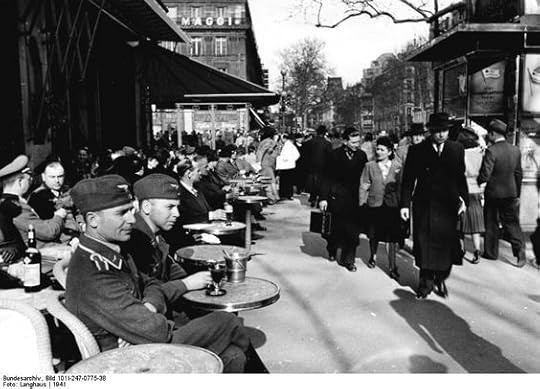
German Luftwaffe officers at café on Boulevard Saint-Germain, Paris, 1941 (German Federal Archive: Bild 101I-247-0775-38 / Langhaus / CC-BY-SA 3.0)
What would Paris be without fine food? Even before the German invasion, the French government instituted food rationing. After the Germans occupied Paris, rationing intensified. Most staples were rationed – meat and fish, milk and cheese, eggs, coffee, sugar, butter and oils, bread, and wine. To obtain your ration meant standing in long lines at the bakery, the butcher, the creamery, the greengrocer – and more. If the store actually had foods in stock.
Ration coupons were issued according to age, with extra rations for those in agricultural work or manual labor. Still, the average adult received rations providing only 1200 calories per day. The average Parisian lost 4-8 kg during the war, and malnutrition and anemia were rampant.
To get by, Parisians visited the country, where food was less scarce, or they bought on the black market. For the wealthy, eating at pricey restaurants provided an escape. Ersatz coffee made from barley or chicory provided an imperfect alternative.
EnergyWinter in Paris during World War II was cold. The winter of 1940-41 was one of the coldest on record in France, and snow fell in Paris in December 1941, leading to sledding down hills.
French citizens received little to no coal or heating oil. The supply of electricity was erratic, and cooking gas was often provided only during meal preparation times. Families often slept in the kitchen for warmth and kept overcoats on inside.
Transportation
Velo-taxis in Paris, spring 1945 (Imperial War Museum: D 24176)
Most tourists to Paris love to visit the Arc de Triomphe and watch the cars and taxis hurtling around the roundabout with much honking of horns. During the war, the streets of Paris were all but silent.
Late-model automobiles were requisitioned, and driving permits were issued only to Germans, French physicians, midwives, firemen – and some influential collaborators (called collabos by the French).
Most people got around by foot or bicycle. The Métro ran, but stops were often closed, and sometimes the system shut down due to lack of electricity, especially later in the war. Bicycle-driven vélo-taxis and horse-drawn carriages helped people get around.
Fashion
“Paris Book Stalls on the Left Bank,” showing US soldiers after the liberation of Paris – and Parisiennes in bright fashions, by Army Artist Gladys Rockmore Davis (US Army Center of Military History)
The fashion houses of Paris continued to produce beautiful couture garments – many of which were sent to Germany.
But the average Parisienne had to get by. Wool, silk, and leather were all shipped to Germany, so most garments were made of rayon or fibranne – or made from old garments or blankets. Since leather shoes weren’t available, women wore platform shoes with thick soles of wood or cork, which wore down over time.
Fashion was one way the women of Paris thumbed their noses at the Germans. Hats and turbans in vibrant shades and outrageous styles allowed women to show their individual style. Although trousers were outlawed in France, women wore them anyway or chose culottes that looked like skirts. Women wore their skirts shorter and fuller than in other areas of the world, partly to help in riding their bicycles – and partly to scandalize the Germans.
Système DDespite these everyday difficulties – and the far greater difficulties of living under the terror of Nazi occupation – the average Frenchman and Frenchwoman got by. They made do in horrific circumstances. While the City of Lights was dimmed, it never lost its charm.
Please leave a comment below before entering the main giveaway!
The post Winter in Wartime Paris first appeared on Sarah Sundin.Today in World War II History—January 22, 1942
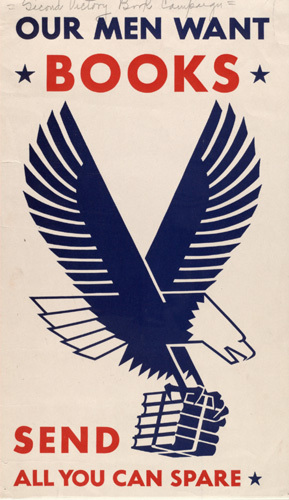
Poster from the US Victory Book Campaign, 1942-43
80 Years Ago—Jan. 22, 1942: Soviets begin evacuation of 440,000 citizens from besieged Leningrad over ice road across Lake Ladoga.
A series of rallies for the Victory Book Campaign begins at the New York Public Library (Read more: “Books in World War II”).
The post Today in World War II History—January 22, 1942 first appeared on Sarah Sundin.January 21, 2022
Today in World War II History—January 21, 1942
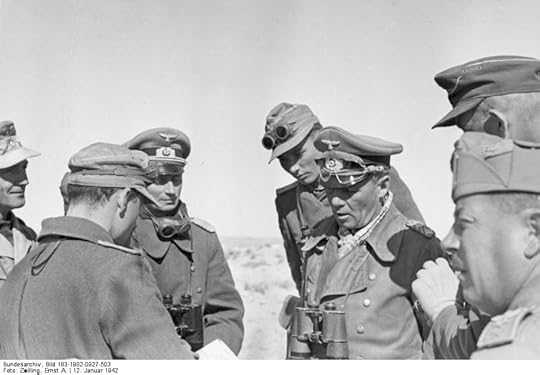
General Erwin Rommel and officers at El Agheila, Libya, 12 Jan 1942 (German Federal Archive: Bild 183-1982-0927-503)
80 Years Ago—Jan. 21, 1942: German forces under Gen. Erwin Rommel attack British at El Agheila, Libya; will drive 350 miles in 17 days.
Japanese begin air offensive against New Guinea.
Count Basie records hit song “One O’Clock Jump.”
The post Today in World War II History—January 21, 1942 first appeared on Sarah Sundin.January 20, 2022
Today in World War II History—January 20, 1942

List of Jewish populations by country used at the Wannsee Conference, 20 Jan 1942 (public domain via Wikipedia)
80 Years Ago—Jan. 20, 1942: At the Wannsee Conference, Nazis under SS security chief Reinhard Heydrich plan the “Final Solution” to the “Jewish Problem.”
Japanese launch main attack into southern Burma from Thailand.
In Paris, the novel Le Silence de la mer by Jean Bruller (pseudonym Vercors) is published, the first French underground book of the war and the first Éditions de Minuit publication (Midnight Editions).
The post Today in World War II History—January 20, 1942 first appeared on Sarah Sundin.January 19, 2022
Today in World War II History—January 19, 1942

Maj. James Stewart confers with B-24 crewmen, England, 1944 (US Air Force photo)
80 Years Ago—Jan. 19, 1942: British North Borneo surrenders to Japanese at Sandakan.
Actor James Stewart receives his wings and commission in the US Army Air Forces.
Off Cape Hatteras, NC, German U-boat U-123 sinks Latvian freighter Ciltvaira and US freighters City of Atlanta and Norvana.
The post Today in World War II History—January 19, 1942 first appeared on Sarah Sundin.January 18, 2022
Today in World War II History—January 18, 1942
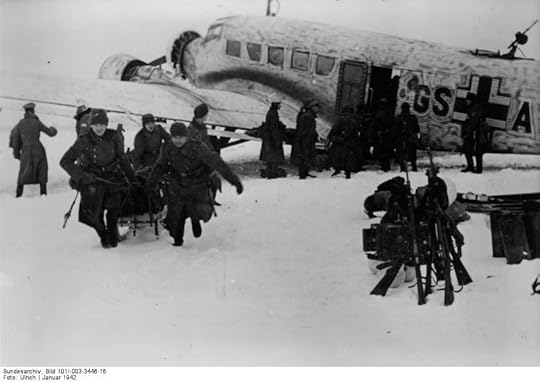
German troops in the Demyansk Pocket unloading supplies from a Ju 52 transport, Jan 1942 (German Federal Archive: Bild 101I-003-3446-16)
80 Years Ago—Jan. 18, 1942: As Japanese advance, RAF withdraws bombers from Singapore to Sumatra.
Field Marshal Fedor von Bock assumes command of German Army Group South.
Dutch begin to destroy oil facilities at Balikpapan, Borneo, so they won’t fall into Japanese hands.
Soviets surround Germans at Demyansk, Russia; German troops will be supplied by air.
The post Today in World War II History—January 18, 1942 first appeared on .January 17, 2022
Today in World War II History—January 17, 1942

British poster about convoys to Russia, WWII (Source: British government)
80 Years Ago—Jan. 17, 1942: Field Marshal Walther von Reichenau of German Army Group South dies of a stroke.
British and South African troops take Halfaya Pass on the Egyptian border and take 5500 Axis POWs.
Off Murmansk, German U-boat U-454 sinks British destroyer Matabele in convoy PQ-8, the first U-boat group action against an Allied Arctic convoy.
The post Today in World War II History—January 17, 1942 first appeared on .January 16, 2022
Today in World War II History—January 16, 1942

US War Production Board seal
80 Years Ago—Jan. 16, 1942: On the Bataan Peninsula in the Philippines US attacks Japanese at Morong in last US horse-led cavalry charge in history.
The US Consolidated B-24 Liberator bomber first flies in combat—from Java.
US War Production Board (WPB) is formed under Donald M. Nelson.
Actress Carole Lombard is killed in a plane crash near Las Vegas while on a war bond tour, age 33.
The post Today in World War II History—January 16, 1942 first appeared on .January 15, 2022
Today in World War II History—January 15, 1942
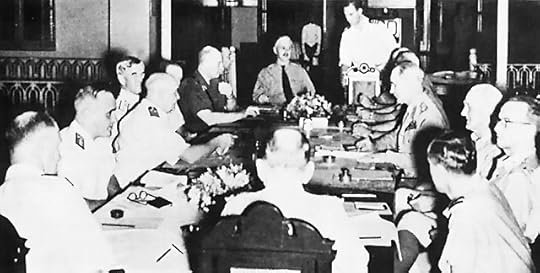
ABDA command meeting, 10 Jan 1942 (public domain via WW2 Database)
80 Years Ago—Jan. 15, 1942: ABDA Command headquarters (American, British, Dutch, Australian) opens under Gen. Sir Archibald Wavell at Batavia, Java.
Jawaharlal Nehru succeeds Mahatma Gandhi as head of India’s Congress Party.
To recruit people to work as codebreakers at Britain’s Bletchley Park, a competition is held: those who complete the Daily Telegraph crossword puzzle in 12 minutes are invited to interview.
Pres. Franklin Roosevelt asks the baseball commissioner to continue the sport during the war.
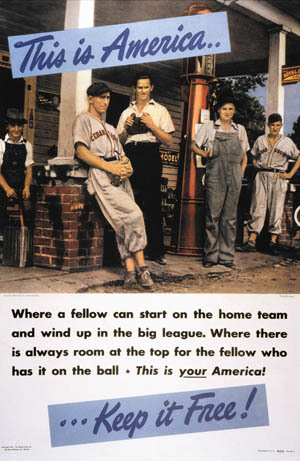
Baseball-themed recruiting poster, 1942
The post Today in World War II History—January 15, 1942 first appeared on .January 14, 2022
Today in World War II History—January 14, 1942
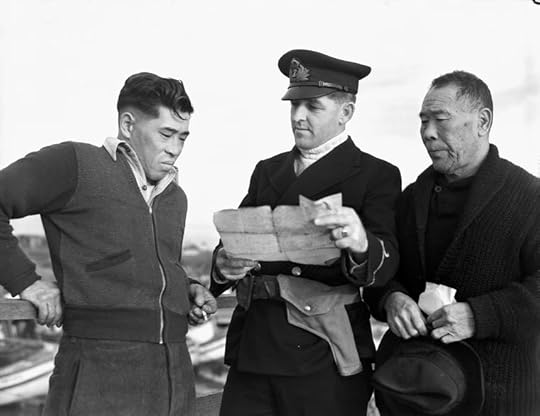
Royal Canadian Navy officer questioning Japanese-Canadian fishermen while confiscating their boat, 9 Dec 1941 (Library & Archives Canada: DAPDCAP 556450)
80 Years Ago—Jan. 14, 1942: Off Long Island, German U-boat U-123 sinks Panamanian tanker Norness, the first sinking in US waters.
Ports of Boston, Portsmouth, and Portland, Maine are closed temporarily due to the U-boat warning.
Canada designates a 100-mile security zone in British Columbia; all males of Japanese ancestry ages 18-45 are ordered to vacate; 23,000 men will be sent to labor camps; women and children are deported to six inner BC towns; Japanese-Canadians also banned from fishing and using shortwave radios.
The post Today in World War II History—January 14, 1942 first appeared on .


